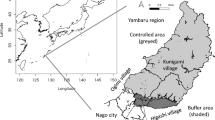Abstract
We used a generalized linear model (GLM) to investigate environmental characteristics of capture sites of the invasive small Indian mongoose (Herpestes auropunctatus) on Amami Island, Japan. Data were collected from 2002 to 2011, from an area with the lowest mongoose density. Data on capture levels and environmental factors were obtained within 1 × 1 km grid cells. In addition, we developed an evaluation map that predicts the occurrence of mongooses throughout the island by extrapolating the 2011 results, in which the last mongoose appearance was confirmed. We found that environmental characteristics of capture sites drastically changed during the final stage of the eradication project. From 2002 to 2010, mongooses were captured in grid cells with many gentle ridges. In 2011, when mongoose density became exceedingly low, mongooses seem to have survived in the grid cells with abundant steep ridges, where it was difficult to establish traps. Therefore, environmental factors affected capture levels and the density of the mongoose population. The evaluation map predicts that mongooses could survive on the southwest and southeast island peninsulas. This evaluation map will be helpful in allocating limited labor and financial resources toward the most effective capture strategies. This study suggests that an analysis of pest management data is an important step in the eradication of mongooses. Our results can contribute to long-term projects in invasive pest management not only for the mongoose population on Amami Island, but also for other invasive species globally.





Similar content being viewed by others
References
Abe S, Handa Y, Takatsuki Y, Nigi H (1999) Food habitats of Feral Mongoose (Herpestes sp.) on Amami-oshima, Japan. In: Rodda GH, Sawai Y, Chiszar D, Tanaka H (eds) Problem snake management: the habu and brown tree snake. Cornell University Press, New York, pp 372–383
Barun A, Simberloff D, Budinski I (2010) Impact of the small Indian mongoose (Herpestes auropunctatus) on native amphibians and reptiles of the Adriatic islands, Croatia. Anim Conserv 13:549–555
Barun A, Hanson CC, Campbell KJ, Simberloff D (2011) A review of small Indian mongoose management and eradications on islands. In: Veitch CR, Clout MN, Towns DR (eds) Island invasives: eradication and management. IUCN, Gland, pp 17–25
Courchamp F, Chapuis JL, Pascal M (2003) Mammal invaders on islands: impact, control and control impact. Biol Rev 78:347–383
ESRI Arc GIS Resources (http://resources.arcgis.com/ja/home). Accessed 11 Nov 2015
Fukasawa K, Hashimoto T, Tatara M, Abe S (2013a) Reconstruction and prediction of invasive mongoose population dynamics from history of introduction and management: a Bayesian state-space modelling approach. J Appl Ecol 50:469–478
Fukasawa K, Miyashita T, Hashimoto T, Tatara M, Abe S (2013b) Differential population responses of native and alien rodents to an invasive predator, habitat alteration and plant masting. P R Soc B 280:20132075
Hays WST, Conant S (2007) Biology and impacts of Pacific island invasive species. 1. A worldwide review of effects of the small Indian mongoose, Herpestes javanicus (Carnivora: Herpestidae). Pac Sci 61:3–16
King CM, McDonald RM, Martin RD, Dennis T (2009) Why is eradication of invasive mustelids so difficult? Biol Conserv 142:806–816
Lowe S, Browne M, Boudjelas S, De Poorter M (2000) 100 of the world’s worst invasive alien species: a selection from the world’s worst invasive alien species. ISSG, SSC and IUCN
Mack RN, Simberloff D, Lonsdale WM, Evans H, Clout M, Bazzaz F (2000) Biotic invasions: causes, epidemiology, global consequences, and control. Ecol Appl 10:689–710
Ministry of Land, Infrastructure, Transport, and Tourism Geospatial Information Authority of Japan (2009) Basic geographic data of Japan (http://www.gsi.go.jp/kiban). Accessed 11 Nov 2015 (in Japanese)
Ministry of the Environment (2009) The national survey on the natural environment (http://www.vegetation.biodic.go.jp/index.html). Accessed 11 Nov 2015 (in Japanese)
Myers N, Mittermeier RA, Mittermeier CG, Fonseca GAB, Kent J (2000) Biodiversity hotspots for conservation priorities. Nature 403:853–858
Naha Nature Conservation Office, Japan Wildlife Research Center (2012) Annual report of the small Indian mongoose eradication project on the island of Amami-Oshima, FY2011. Naha Nature Conservation Office, Ministry of the Environment, Japan (in Japanese with English abstract)
Patou ML, Mclenachan PA, Morley CG, Couloux A, Cruaud C, Jennings AP, Veron G (2009) Molecular phylogeny of the Herpestidae (Mammalia, Carnivora) with a special emphasis on the Asian Herpestes. Mol Phylogenet Evol 53:69–80
R Development Core Team (2013) R: a language and environment for statistical computing. Vienna, Austria
Vitousek PM (1990) Biological invasions and ecosystem processes: towards an integration of population biology and ecosystem studies. Oikos 57:7–13
Watari Y, Takatsuki S, Miyashita T (2008) Effects of exotic mongoose (Herpestes javanicus) on the native fauna of Amami-Oshima Island, southern Japan, estimated by distribution patterns along the historical gradient of mongoose invasion. Biol Invasions 10:7–17
Watari Y, Nishijima S, Fukasawa M, Yamada F, Abe S, Miyashita T (2013) Evaluating the ‘recovery level’ of endangered species without prior information before alien invasion. Ecol Evol 3:4711–4721
Whittaker RJ, Fernandez-Palacios JM (2007) Island biogeography: ecology, evolution, and conservation, 2nd edn. Oxford University Press, Oxford
Yamada F (2002) Impacts and control of introduced small Indian mongoose on Amami Island, Japan. In: Veitch CR, Clout MN (eds) Turning the tide: the eradication of invasive species. IUCN SSC Invasive Species Specialist Group, IUCN, Gland and Cambridge, pp 389–392
Yamada F, Sugimura K, Abe S, Handa Y (2000) Present status and conservation of the endangered Amami rabbit Pentalagus furnessi. Tropics 10:87–92
Yasuma S (2001) Ryukyu Islands: biodiversity and the origin of the islands. The Tokai University Press, Kanagawa (in Japanese)
Author information
Authors and Affiliations
Corresponding author
Electronic supplementary material
Below is the link to the electronic supplementary material.
Rights and permissions
About this article
Cite this article
Komine, H., Takeshita, K., Abe, S. et al. Relationships between capture-site characteristics and capture levels of the invasive mongoose on Amami-Oshima Island, Japan. Biol Invasions 18, 487–495 (2016). https://doi.org/10.1007/s10530-015-1021-1
Received:
Accepted:
Published:
Issue Date:
DOI: https://doi.org/10.1007/s10530-015-1021-1




